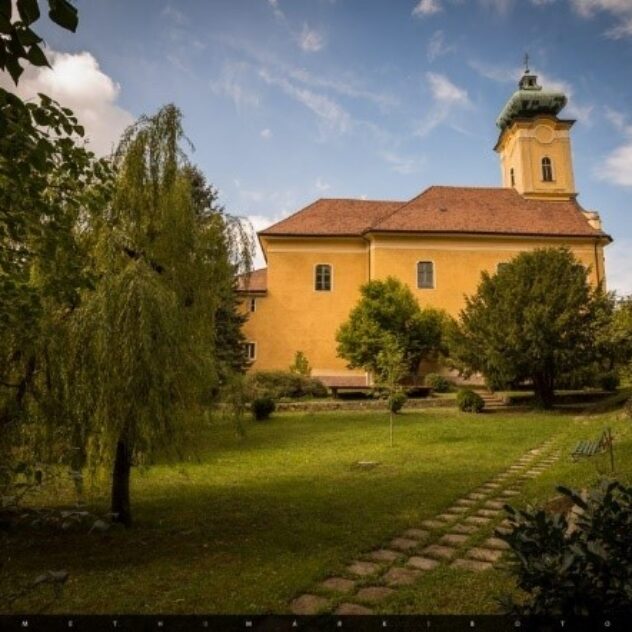Queen of Angels shrine
Information about the pilgrimage site
In the Middle Ages, the village of Alkeszi housed a church dedicated to Saint George, probably of Romanesque origin, which according to some sources was not destroyed during the Turkish subjugation, while according to other sources, the church was razed to the ground by the Turks.
A church was built on the site of this old church, or on its ruins, by renovating it after the departure of the Turks , we don’t know exactly when. This church was already a church of Mary. The fact is that the registers contain baptism entries since 1699, and in 1713 two bells were consecrated. The oldest seal of the village – which was used since 1698 – shows a church, which is probably the built or rebuilt church. The canonica visitatios (bishop’s visits) of 1747 and 1752 all reported on an existing building, but standing on the remains of an older church. Instead of this or instead, between 1761 and 1766, our current baroque church was built, to the construction costs of which Miklós Zichy and Erzsébet Berényi contributed greatly.
Soon many people started visiting this place. Bishop Ádám Acsádi (1680-1744) of Veszprém investigated the events and allowed the holy image to be publicly venerated. A small chapel was built above the image of Mary with donations from the pilgrims. Two hermits living nearby undertook to take care of him. The growing interest resulted in the Trinitarian monastic order operating in Óbuda building a beautiful single-tower church and a small monastery here.
Ignác Koller (1725-1773), bishop of Veszprém, consecrated the church in 1768 in the presence of more than ten thousand pilgrims: The trunk of the oak tree and the icon were placed in the church. Within a short time, 50 miraculous healings and prayer hearings took place here through the intercession of the Holy Virgin.
Tourist attractions in the vicinity
Svábhegy Observatory – hungary’s oldest and largest academic observatory institute. “Located at the top of Svábhegy, 300 meters from Normafa, in a wooded area. The institute’s buildings and domes are situated in a beautiful park on an 8-acre old-growth forest area. Visitors to the observatory can explore three observatory domes, including Budapest’s largest telescope, a meridian house, a research building, and a technical laboratory.” (source: Why Visit Us? – svabhegyicsillagvizsgalo.hu)
Piczinke Pony Yard – popular among families with children, this petting zoo is located near Normafa. Visitors can pet alpacas, ponies, rabbits, llamas, and miniature pigs. Additionally, there are opportunities for horseback riding, go-karting, trampolining, and exploring a large “goat-themed” playground.
Normafa – situated in the heart of the Buda Hills, Normafa offers unparalleled views of Budapest. Well-developed hiking trails provide excellent opportunities for hiking enthusiasts. Recently, new playgrounds have been built for children, and a rubberized running track has been constructed for sports enthusiasts.
Budakeszi Wildlife Park – its aim is to showcase wildlife species living in Hungary and turn this experience into a complex adventure focusing visitors’ attention on the beauty of nature. More than 50 animal species, a petting zoo, an adventure park, and playgrounds await visitors.
Aquaworld Resort Budapest – umerous adventure pools and 11 giant slides await adrenaline enthusiasts. Budapest’s largest sauna complex offers daily renewing sauna sessions for those interested.
Other tourists attractions in the vicinity of the pilgrimage site can be found on the website of Local tourism Authority of Budakeszi: https://varoshaza.budakeszi.hu/latnivalok/
Accommodation
- Accommodation for pilgrims in the Pilgrim Hostel of Saint John the Baptist ( HaloZSEK Zsámbéki zarándokszállás – halozsek.hu)
- Other private accommodation in the vicinity of the pilgrimage site.
Availability
By car
The temple, located 17.9 km away, can be reached in 25 minutes via the M7 motorway. It is situated on the right side of the road after turning off from Makkosi Road.
By public transport
It takes 2 hours to reach from Érd. After getting off the bus heading towards Csillebérc at the final stop, you can walk for 22 minutes to cover the 2 km distance to the pilgrimage site.
On foot
For most of the route, walking is only possible along the main road, with the option to switch to the designated hiking trail for the last few kilometers. The total distance can be covered in 3 hours and 50 minutes.
On a bicycle
You can reach it in 1 hour and 15 minutes through Törökbálint. Expect some minor inclines and elevation differences along the way.







